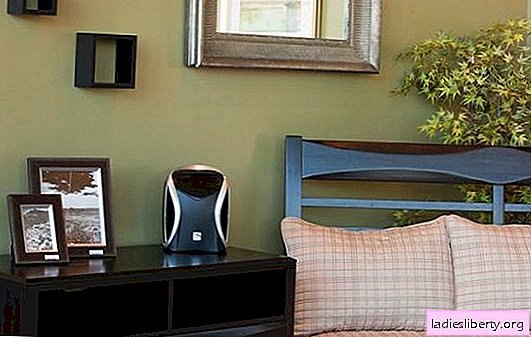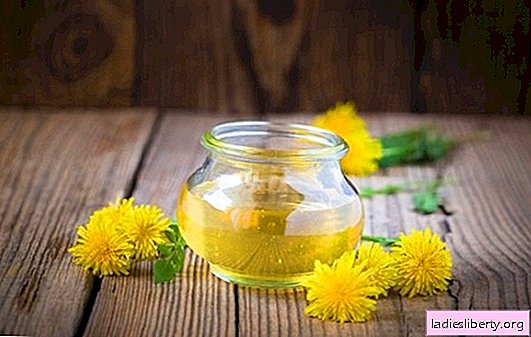
When buying a household ozonizer, we expect to always get clean, fresh air in a house or apartment, in which there will be no pathogenic bacteria or harmful viruses. Is it really? Here is a question that you should ask yourself before buying an ozonizer. The harm from this undoubtedly useful device can turn out to be an unpleasant and dangerous surprise.
Ozone: what is it
First of all, it is worth understanding what ozone is. It is a bluish-colored gas that consists of three oxygen atoms. Liquefied ozone is indigo, while in solid state it is dark blue.
Despite the beauty and atomic proximity to life-giving oxygen, ozone in terms of its potential danger to humans surpasses the combat sending substances - chlorine and hydrocyanic acid. Ozone poisoning can be fatal.
During a severe thunderstorm, the air is so saturated with ozone that it acquires a characteristic odor. We associate it with the freshness of a thunderstorm, try to breathe stronger, breathe in delicious air. In fact, the scent of thunder is the scent of ozone. Lightning discharges break down oxygen into atoms, which easily form unstable triatomic molecules of ozone gas.
Natural ozone in the air quickly collapses, forming active oxygen - that is, a substance that oxidizes everything it comes into contact with. During the oxidation of metal, rubber, living organisms, either a change in properties or destruction occurs.
By the way, it is the oxidative processes in the body that lead to cell modification, the aging of the body. Special antioxidant substances fight these processes. So do we need to breathe ozone, and even acquire special ozonizer devices?
Ozonizer and ionizer: what is the difference
When choosing a household appliance for an apartment, two concepts should be distinguished: air ozonation and air ionization.
The task of the ozonizer is to develop an amount of ozone that is not harmful to health in order to oxidize, that is, to destroy pathogenic microflora at the level of molecules. This is achieved by generating current discharges in the device. How much gas it can produce depends on the power of the device. Ozone destroys not only bacteria and viruses present in the air, but also a specific smell, tobacco smoke, destroys moths and other insects. In this sense, the benefit of the ozonizer is obvious.
The ionizer performs another task. It does not oxidize indoor air, although by the principle of operation it is similar to an ozonizer (an electric discharge is also created there). The essence of the ionizer is to fill the volume of air in the room with “healthy”, living air, and not to oxidize the existing volume. By producing ions, the device improves air quality by increasing the concentration of electrically charged oxygen particles.
Today, there are household ozonizer ionizers on sale that combine the functions of purifying the air and saturating it with ions. The ozonizer has no contraindications. However, it must be understood that oversaturated air becomes hazardous to health and life. Loss of consciousness and a strong cough are the easiest consequences of poisoning.
If the amount of ozone compounds is normal, breathing air is actually easy and pleasant. But the "smell of thunderstorm" in this case is not felt, and this is a very good sign.
The use of ozonizer, types of devices
A low concentration of ozone generated by a household ozonizer is favorable for a person. Useful properties of the device are its ability to deodorize and disinfect air in a living room. This is especially true in the season of influenza and SARS, because it allows you to avoid infection or, in any case, faster to recover.
Ozone destroys any pathogenic microflora present in air and water: bacteria, viruses, microorganisms, fungi. Atomic oxygen is also detrimental to unicellular parasites. In addition, it really destroys odorous compounds by deodorizing indoor air.
The effect of ozone in the sense of disinfection is similar to the effect of chlorine, which is used in hospitals and places of residence of a large number of people. However, ozone has no inherent harmful side effects of chlorine. Today, ozone disinfection will be used to purify water on commercial fish farms, in public pools, water treatment plants, pharmaceutical plants, bottled water bottling plants, etc.
Types of household ozonizers vary. You can buy a device for disinfection:
• indoor air. When air is ozonized, a metered amount of gas is produced that is sufficient for the oxidation of pathogenic microflora, that is, the destruction of viruses, bacteria, fungus, etc. The device must be used strictly according to the instructions, otherwise nothing but harm from the ozonizer can be obtained;
• drinking water. Treated water can be safely drunk, as ozone is a very unstable gas that is destroyed without a trace. Boil such water is not necessary: it is cleaned of all harmful;
• food. They are indispensable for providing families with safe food. After saturating the right amount of ozone with water, it is possible to dip fruits, vegetables, fish, meat, etc., treated with chemicals, and both the chemistry and the infection will be destroyed;
• pool or aquarium. This is an important task for both aquarists and owners of small private pools. The device perfectly copes with its task, purifies water, eliminates an unpleasant musty smell;
• car. Car owners can buy an ozonizer for fuel, which is installed in the engine and can improve the quality of gasoline. The machine will last longer and will cause fewer problems.
There are universal devices that can perform several tasks simultaneously.
Ozone damage
Ozone toxicity is the main danger when using household ozonizers. Useful properties in case of exceeding the permissible concentration turn into its exact opposite. Moreover, ozone poisoning can lead to death from paralysis of the lungs, so it is important to carefully follow all the manufacturer's instructions.
How to find out that the safe ozone content in the air is exceeded? Here are some signs:
• polymer coating is destroyed;
• metal and rubber deteriorate;
• electrical appliances fail;
• instead of vigor, people feel constant fatigue, depression, experience nervous disorders;
• constant headaches begin to torment.
Constant excess of ozone in the air provokes the development of cancer, infertility, atherosclerosis. Using household ozonizers, it is important to constantly ventilate the room. The norm of ozone content is 0.1 mg / m ?.
If the ozone concentration is exceeded very strongly, it smells pungent in the air, eyes begin to watery, it is difficult for a person to breathe, sore throat, nausea, allergic skin and respiratory reactions occur.
Contraindications for the use of ozonizer
Do not rely on your sense of smell, bearing in mind the control of ozone concentration in the room. This is too unreliable tool. It is worth falling asleep without turning off the device, and the consequences may be irreversible. In addition, if the air "smells of thunder", this is a sure sign of a significant excess of gas concentration.
Despite the fact that the ozonizer really has no contraindications, it is better to decontaminate the premises in the absence of people. After the procedure, it is important to properly ventilate the room. It is forbidden to use the device if the humidity is above 95% or the room is fire hazard.
In any case, it is necessary to carefully control the process of ozonation of air and water, following all the instructions of the device manufacturer. Only in this case, the use of an ozonizer eliminates the potential risk to health and life.











